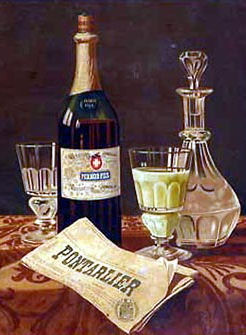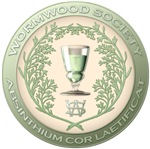absinthe
Absinthe is an anise-flavored aperitif distilled from anise, Florence fennel and wormwood. Through a mistaken belief that it induced madness, it was banned almost world-wide in the early 1900's. Once it was banned, a substitute was needed, and so various companies came out with products which had a similar flavor profile, the term "Pastis" was coined by the Ricard company to refer to this product.
A difference between Absinthe and Pastis, is that Pastis will typically be pre-sweetened, while Absinthe is not.
A few years ago, it was noticed that the US ban against absinthe was specifically targeting “thujone”, which had been incorrectly thought to be hallucinogenic. It had also been incorrectly believed that absinthe should be high in thujone since wormwood, one of the key components of absinthe, contained thujone. Distillation however strips out virtually all of the thujone from absinthe, which means that real absinthe will be technically “thujone free”. This allowed producers of real absinthe to begin marketing their products in the US, as well as allowing US distillers to start producing absinthe.
The following recipes on this site use absinthe:
- Attention
-
gin,
dry vermouth,
crème de violette,
absinthe,
orange bitters,
- Biter
-
gin,
lemon juice,
simple syrup,
Chartreuse,
absinthe,
- Chrysanthemum Cocktail
-
dry vermouth,
Benedictine,
absinthe,
- Clipper Ship
-
gin,
St-Germain,
lime juice,
absinthe,
- Corpse Reviver #2
-
gin,
lemon juice,
Cointreau,
Lillet blanc,
absinthe,
- De La Louisiane
-
rye whiskey,
sweet vermouth,
Benedictine,
absinthe,
Peychaud's bitters,
- Death in the Afternoon
-
absinthe,
champagne,
- Goat's Delight
-
kirschwasser,
brandy,
heavy cream,
orgeat,
absinthe,
- Gotham
-
absinthe,
peach bitters,
brandy,
- Monkey Gland
-
gin,
orange juice,
grenadine,
absinthe,
- Morning Cocktail
-
brandy,
dry vermouth,
orange curaçao,
maraschino liqueur,
absinthe,
Angostura Bitters,
- Obituary Cocktail
-
gin,
dry vermouth,
absinthe,
- Robert Burns
-
Scotch whisky,
sweet vermouth,
orange bitters,
absinthe,
- Sazerac
-
absinthe,
simple syrup,
Peychaud's bitters,
rye whiskey,
- Sherman
-
sweet vermouth,
rye whiskey,
absinthe,
Angostura Bitters,
orange bitters,
- Twenty-First Century Cocktail
-
tequila,
crème de cacao,
lemon juice,
absinthe,
Discovering the Green Fairy
 Absinthe is a distilled liquor that has a anise or slight licorice flavor (but it doesn't typically include licorice). It's name comes from a particular type of wormwood (Artemisia absinthium), which is one of the ingredients that provides part of its distinctive flavor. It is also wormwood that was (mistakenly) believed to cause people to trip, or hallucinate, and do such things as commit murder, suicide, or mad rampages.
Absinthe is a distilled liquor that has a anise or slight licorice flavor (but it doesn't typically include licorice). It's name comes from a particular type of wormwood (Artemisia absinthium), which is one of the ingredients that provides part of its distinctive flavor. It is also wormwood that was (mistakenly) believed to cause people to trip, or hallucinate, and do such things as commit murder, suicide, or mad rampages.
Absinthe is typically served in what is referred to as an "Absinthe Drip". This starts with an ounce of abisnthe in the bottom of a specially designed glass, overtop of which you place a special Absinthe Spoon, on top of which is placed a cube of sugar. You then slowly drizzle ice-cold water over the sugar cube. This will slowly dissolve the sugar cube and the sweetened water will then fall into the absinthe waiting below (sugar doesn't dissolve well in alcohol, which is part of the reason for this step). The cold water will also cause the absinthe to "louche", which basically just means "turn cloudy". You typically will add about 4 times as much ice-water as you used in absinthe.
Because of a heavy campaign based on the rumors surrounding the effects of wormwood, absinthe was banned nearly world-wide around 1915, with only a couple of countries continuing to produce it. In the mid 1990's absinthe began to poke its head up again, usually through products imported into England from the Czech Republic, which had just begun making a product they were calling Absinth (note no "e"), but which was not made using authentic methods, and often not using authentic ingredients. Because this "new" style of absinthe didn't louche up, they devised a new ritual in which you would soak a sugar cube with their product, set it afire, and after letting it burn for a while pour the water over it to put out the fire. To absinthe connoisseurs, this ritual is viewed as an afront to the product, and should be avoided at all costs as it destroys the flavor experience of a real absinthe.
Over the last few years, absinthe has been gradually been legalized around the world as countries come to realize that there really isn't anything wrong with it. Here in the United States, absinthe is once again available for sale, even though there were no changes at all to any of the rules which previously prevented its sale.
It had long been thought that it was the "thujone" in absinthe which was the problematic ingredient. Tests done on animals with pure thujone would show that it would cause seizures, or sometimes even death, which to many illustrated its danger. A study was done several decades ago in order to determine how much thujone was in absinthe. The calculation was done by simply looking at a traditional absinthe recipe, looking at the amount of thujone which was in the ingredients being used, and assuming that that same amount of thujone would be in the final product. What they didn't take into account however, was that absinthe is a distilled product, and the distillation process strips out virtually all of the thujone. True absinthe is almost completely thujone free.
The laws in the United States required that all products are "thujone free", even though true absinthe is "almost" thujone free, there is still a very small amount of thujone in the bottled product. It was then noticed however that the test which was going to be used by the government had 10 parts per million "false positive" allowance. While nobody had yet gone through the expense of actually testing authentically produced absinthe, it was believed that it should be within this acceptable allowance. Once the tests were done, it was found that many authentic absinthes were closer to 2 parts per million of thujone. This is why there are now several brands of absinthe available for sale in the United States. It also means that many of the improperly made absinthes (which intestinally boost their thujone levels so they can play to the market which thinks it is a hallucinogen), will not be able to be sold in the US.
 If you are interested in more details and information about Absinthe, I suggest you check out The Wormwood Society website, specifically reading the great FAQ that they have developed to help educate people about the various myths surrounding this product. They also have a discussion forum where various absinthe experts and beginners from around the world share thoughts, insights, information, and news related to absinthe.
If you are interested in more details and information about Absinthe, I suggest you check out The Wormwood Society website, specifically reading the great FAQ that they have developed to help educate people about the various myths surrounding this product. They also have a discussion forum where various absinthe experts and beginners from around the world share thoughts, insights, information, and news related to absinthe.